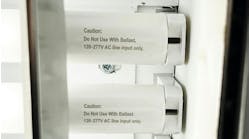DOE Announces Integrated Lighting Campaign’s 2021 Recognized Participants
The Better Buildings Initiative under the U.S. Department of Energy (DOE) recently released the Integrated Lighting Campaign’s recognized sites and partners in a webinar presented Tracy Beeson and Felipe Leon from the Pacific Northwest National Laboratory (PNNL) on September 1. The Integrated Lighting Campaign’s goals include providing relevant resources to inform projects; promoting the use of innovative lighting sensors; encouraging integration with other building systems such as HVAC; and documenting and recognizing innovative integration projects.
The 2021 recognized participants were recognized for one or more of the following categories: Advanced use of sensors and controls for lighting; integrated controls for plug loads and lighting systems; integrated controls for HVAC and lighting systems; and other integrated systems and lighting. In addition, two projects were recognized for advanced sensors and controls for innovative outdoor projects.
The 13 recognized participants include:
- Bryan Health System, which upgraded 3 million sq ft of building portfolio across two campuses in Lincoln, Neb., resulting in 57% energy savings.
- California State University-Dominguez Hills, which upgraded a 179,222-sq-ft multi-use building in Carson, Calif., for 34% energy savings due to its lighting upgrade and 27% energy savings from its HVAC integration.
- City of Wilmington, Del., which replaced 1,732 existing streetlights for 69% energy savings and streamlined maintenance.
- Denver Water, which featured HVAC integration for 2-4% anticipated energy savings in new construction of a 186,930-sq-ft LEED Platinum Building in Denver.
- IMEG Corp., which upgraded the lighting system of its 16,500 sq ft of corporate office space in Chicago, reporting 37% below the IECC 2018 standard.
- Johnson Controls Headquarters, which implemented plug load and other integrations in 165,000 sq ft of office space in Milwaukee.
- Massachusetts Port Authority, which replaced 23 existing pole lights at the Conley Terminal Container Yard in Boston, resulting in 55% energy savings.
- Minnesota Department of Transportation, which implemented HVAC and plug load integrations with its lighting systems in its Richfield, Minn.-based, 74,776-sq-ft maintenance facility, for energy savings of 82% (COVID-19 affected results for HVAC) and 71% (COVID-19 affected results for plug load).
- State of Vermont, which employed HVAC and lighting system integrations at two buildings in Burlington, Vermont, the 260,000-sq-ft Zampieri Office Building and 114,000-sq-ft Costello Courthouse.
- U.S. Office of Personnel Management, which integrated controls for HVAC and lighting systems in its 850,000-sq-ft office building in Washington, D.C., for energy savings of 1 million kWh each year.
- University of Minnesota, which reported 46% energy savings for its integration of HVAC and lighting systems in 25,000 sq ft of office space in Minneapolis.
- Walgreen Company, which employed life safety and basket tagging pilots to automate reporting, reduce maintenance costs, identify in-store traffic patterns, and more throughout four retail buildings in Georgia, Illinois, and Tennessee.
- Westover Air Reserve Base, which upgraded its lighting system for 200,000 sq ft of supply space, gymnasium, and aircraft maintenance hangar in Chicopee, Mass., for energy savings of 460,000 kWh each year.
The Better Buildings Initiative is made up of more than 950 organizations sharing their proven energy efficiency strategies. Collectively, these organizations have saved more than 2.2 quadrillion BTUs of energy. The Better Buildings Solution Center provides a range of solutions from implementation models and showcase projects to toolkits, case studies, and other free resources online. To view the full presentation and slides, visit the Better Buildings Solution Center.



